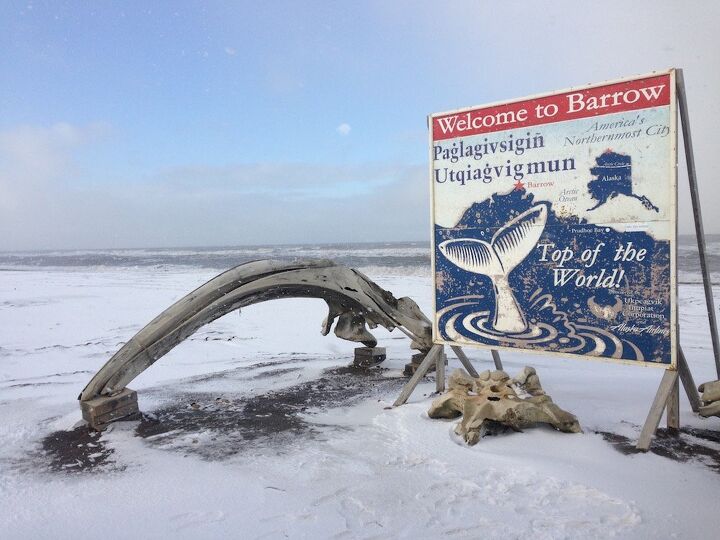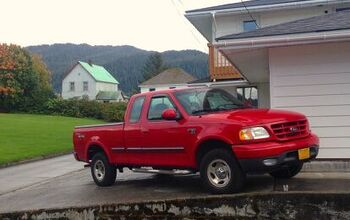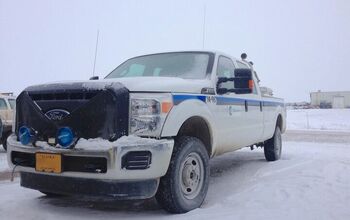U.S. North to South 2015: Barrow, Alaska
Last year, I crossed the United States from Coast to Coast — New York to LA — in a Ram 1500 Tradesman. You can follow last year’s coverage here. This year we embark on another crossing, this time from North to South, albeit starting a little further North than you might expect.
I’ll hop in a Ram 2500 Tradesman 4×4 in Seattle eventually, but for now, as the area I’ll travel through before Seattle has only an intermittent road network, it will be a mix of planes, rental cars and ferries.
So we start north. But how far north? The furthest North we can: Barrow, Alaska, the northernmost settlement in the United States.
As my expertise lies in car sales statistics, for each State we’ll go through I’ll detail the best-sellers locally, let you know if this is verified on location and speak to a few dealers to explain the variations I witness. For Barrow though, the best-sellers — although fascinating — are not representative of Alaska as a whole, so we’ll cover Alaskan figures when we reach Anchorage. You can check out the best-sellers in all 50 States over the Full Year 2014 here.
Barrow, or Utqiaġvik in Inupiaq language, lies on the Arctic Ocean, 320 miles (515 km) north of the Arctic Circle and just 800 miles (1,290 km) south of the North Pole. It is the northernmost city in the United States, with a population of 4,373 as of 2013. Nearby Point Barrow is the U.S.’ northernmost point. And no, we can’t see Russia from our backyard here. Due to its location in north-central Alaska, Barrow is actually 480 miles (770 km) from Russia.
Due to its extreme geographic location, Barrow experiences the longest day and night in the country. When the sun rises on May 10, it doesn’t set again for nearly three months! That’s 85 consecutive midnight suns to be enjoyed. Inversely, when the sun sets around November 18, Barrow residents won’t see it again until around January 22. Yep, you read that right, over two months without seeing the sun! And on the winter solstice — December 21 — we’re talking about 21 hours of pitch-black darkness and a civil twilight of only three hours. Your (and my) first thought when reading this might be “Where is the alcohol?” Bad call, as alcohol beverages aren’t available in Barrow – a “damp” community. More on this later…
It won’t come as a surprise to learn that the Barrow climate is classified as polar. Temperatures continuously remain below freezing from early October through to late May and snowfall can occur during any month of the year. The annual mean temperature in Barrow is 9° F (-13° C), with the average temperature in February, the coldest month, dropping to -19° F (-28° C). The highest temperature ever recorded in Barrow is 79° F (26° C) on July 13, 1993, while the lowest is −56° F (−49° C) on February 3, 1924. The Barrow landscape is tundra and we are walking on a permafrost layer that is as much as 1,300 feet (400 m) deep. All houses in Barrow are built on stilts to avoid melting the permafrost on which they rest.
The Arctic Ocean is threatening the main road in Barrow
I stayed in Barrow on September 28 and 29 while the average temperature during the day was 26° F (-3° C). The days were still long with the sun setting around 8 p.m. but it (logically) remained extremely low in the sky throughout the day and cast very long shadows at midday. Speaking with the locals, I learned that this type of weather at this time of year is dangerously mild, with global warming making its full effects felt in town: There was no ice at all on the Arctic Ocean, and the rough sea was threatening to break the levees, made of earth and sand, that protect the main road in town. Residents in Caterpillar trucks were working overtime to rebuild them. Bob Brouillette from the Top of the World hotel told us that the main road in town was washed out a month ago and had to be completely rebuilt. Later-forming sea ice means flooding risks increase and the Ocean eroding the shore is a totally new occurrence that is understandably worrying the local residents.
Whale cutting in Barrow
The population of Barrow is 60-percent Iñupiat Eskimo, an Inuit Alaska Native group that migrated from islands in the Bering Sea to what is now Alaska around 1000 B.C. For comparison, Alaska Natives as a whole represent 16 percent of today’s state population. Before 1940, Natives were still in the majority. The vast majority of the Iñupiat population, estimated at 19,000 across the United States, lives in Alaska. Alcohol destroyed many Native communities in this part of the world — the main reason why alcohol is not for sale in Barrow (thought it can still be personally imported). A fascinating fact about the Iñupiat (along with most Arctic peoples) is the fact they still rely heavily on subsistence hunting and fishing — harvesting walrus, seal, beluga and bowhead whales, polar and grizzly bears, caribou, moose and fish depending on their location.
No need to be alarmed here. Some of these species are endangered but their harvesting for subsistence purposes is allowed and regulated for Native populations. Case in point, I was in Barrow in the middle of whale migration season and, although there weren’t any whales being butchered on the day I stayed over, the cuts from the previous week’s harvest were visible on houses’ porches and in truck beds. Barrow Native residents are allowed to catch three whales a day during whaling season. A total of 67 whales a year are quotaed to Native communities along the Arctic Ocean, along with residents of Greenland.
Bob Brouillette from the Top of the World Hotel in Barrow proudly showed us the platform north of town where whales are butchered immediately after being tugged onto shore. “A 40-foot whale can be butchered in hours,” Brouillette said. Barrow residents are careful to then dispose the waste whale bones far away from town at Point Barrow as they attract polar bears, a nuisance for locals even if it’s the town’s main touristic attraction. I would have gladly left the bones there myself if it meant I could see a polar bear!
No roads lead to Barrow. The town is surrounded on nearly three sides by the Arctic Ocean, iced a large part of the year except summer, although the icing period is getting shorter and shorter. This means that cargo planes are the only – and expensive – way to ship things to this remote location for a good part of the year. While I was in Barrow, the barge season (July to mid-September) had just ended. During this time, a lot of items, such as cars, are shipped by barge either from Prudhoe Bay or further south in Alaska through the Bering Sea.
Barrow Airport
In March, only when the permafrost is at its deepest, locals create ice roads through the bush to reach the Alaskan road network in Prudhoe Bay to the east. However, with warmer winters come thinning ice. This, in addition to the hundreds of holes from abandoned oil drills in the surrounding National Petroleum Area, makes ground travel relatively dangerous and more unpredictable than it used to be. No local would venture on such trips alone and convoys of six or seven cars are organised in order to stay safe.
Despite the nearby oil being drilled (there was chatter of Shell withdrawing from its Barrow offshore drilling operations while I was there), the gallon of gasoline stands at an eye-popping $7.00/gallon, a staggering contrast compared to the $2.29 national average and $2.73 in Anchorage. The solution: natural gas, available very easily and cheaply in Barrow with open air gas pipes visible in each street. Many pickup trucks here have “Flexfuel” logos on their back, in this case a misnomer as the trucks are not fuelled with a mix of gas and ethanol, instead fitted with Compressed Natural Gas (CNG) and Liquefied Petroleum Gas (LPG) fuel tanks and fuel-delivery systems. At the equivalent of $1 for each gallon of natural gas, you’re looking at $10 at most for a full tank if you fill up from your home gas supply. It would cost over $100 with gasoline. Even if the CNG conversion sets you back $7,500 to $9,500, it’s a no-brainer for Barrow residents. Bob from the Top of the World Hotel wonders why everyone isn’t driving a natural gas-enabled vehicle.
So what cars are so good that Barrow locals go to great lengths to ship them here and fuel them at extortionate prices or go to the trouble of installing a CNG conversion kit? It seems Ford has had a stranglehold on the market for many years now, with a continuous flow of private F-150s and Escapes streaming Barrow’s frozen streets. There is a long heritage of the two nameplates up to the current ones, although I did not spot any all-new 2015 aluminum F-150s. All F-Series generations are very well represented here, all the way back to the 1987 model that’s still present here in large numbers.
There is also a relatively strong heritage of Jeeps. I spotted here the very first Jeep Comanche of my entire life. This is a Jeep Cherokee pickup that was on sale from 1984 to 1992. I also spotted a handful of new Cherokees and a few Wranglers. Also popular in Barrow: Hummers. I spotted four of them in just an hour of walking through town.
As far as fleet cars are concerned, the F-150 is the most popular, followed by a solid count of F-250 and F-350 Super Dutys as well as the Ford Escape and Expedition. The most common taxis are Honda CR-Vs, including one current generation. A few other particularities in Arctic Barrow: People keep their cars running when they go to the supermarket in order to keep the engine warm, even in (almost) summer conditions like now. All outdoor parking lots have an electric outlet for each car. Block heaters keep fluids and the battery from freezing. Finally, I spotted a good number of Fords with a license plate from Sound Found, a car dealership in Seattle, 2,000 miles (3,200 km) away! I will try and crack this enigma when in Seattle…
This concludes our coverage of Barrow, Alaska. Next we are headed east to Prudhoe Bay.
Matt Gasnier is based in Sydney, Australia and runs a website dedicated to car sales statistics, trends and analysis: BestSellingCarsBlog.
The northernmost service station in the U.S. (The Arctic Ocean is in the background)
More by Matt Gasnier
Latest Car Reviews
Read moreLatest Product Reviews
Read moreRecent Comments
- Hi There I dig the boxy retro looks, I don't care if it looks like a Rivian which looks like an old Scout. I'm skeptical about the price, as others have mentioned, my guess is when this ships, in 2027, it'll be $90k. I do like the range extender generator on board. Until we get better battery technology, it's either that or a plug-in hybrid for me. Full EV is fine in an urban environment with access to lots of chargers. Though, the irony there is, once everyone has an EV, finding an open charger will be impossible. So many negatives in the EV future.
- ToolGuy I know some 5 year olds looking for work.
- Jalop1991 Ah. Update: Scout employee has confirmed that the width of the Scout EV Concepts is 79.9 inches without mirrors (and confirmed that it's 91.1" with mirrors). So their marketing department wasn't ready for this launch at all. I seriously doubt this will launch in 2027, or that any of their products will be less than $90K, or that any of them will be available with some sort of combustion engine of any kind.
- Lillian With the Global acceptance and mass increase in active users of Digital currency, comes its many challenges with the most worrisome probably being stolen funds and even emptying your balance to 0.00 USD and this exactly was my experience four days ago after my balance of $110,000 was cleared. Glad I had known about Space Spy Recovery through a close friend whom they helped earlier and once I contacted them, they deployed their high tech expertise and recovered my money back. Contact them for all Crypto solutions: addresses: soacespy@hackermail.com. Telegram: @spacespy65; Skype: live: cid.2b75b0cf1ce9bf69; WhatsApp: +1 (657) 543-6038;
- Kwik_Shift_Pro4X I 🤣😆😂 at the price































































Comments
Join the conversation
Thanks for the pics! I've been waiting for Google Street view to get up to Barrow, but the farthest north that has street view is Inuvik in Canada.
Thank you for this fascinating post. I want to comment on what may seem like a relatively minor editorial practice that really sticks out to me: blurring license plates. I know it's all the rage on reality TV and in photos but I don't get the point. They are meant to be displayed and everyone else on the road can read them. It disappoints me because at least to me license plates are an integral part of car scenery. That said I think the way you've done it, blurring only the letter section of the serial number, is the best compromise I've seen yet if one must bow to this silly convention. So kudos for that.